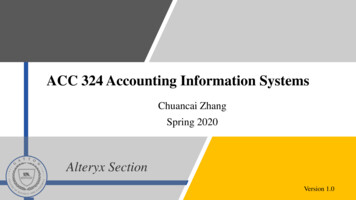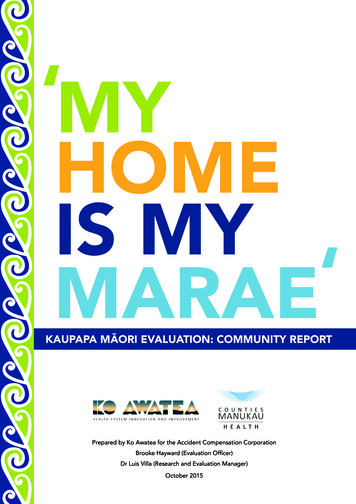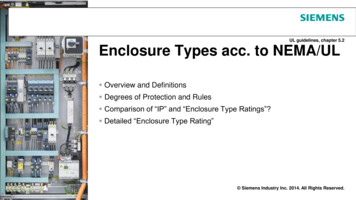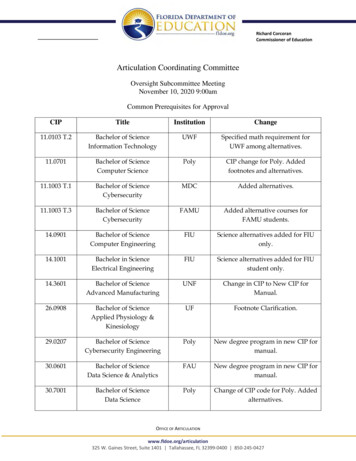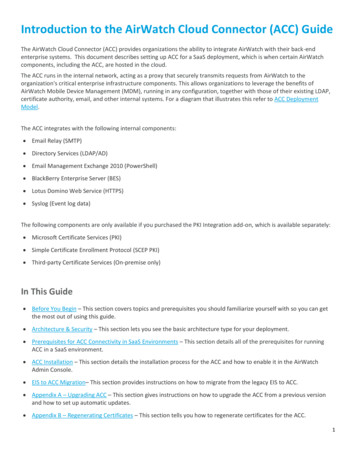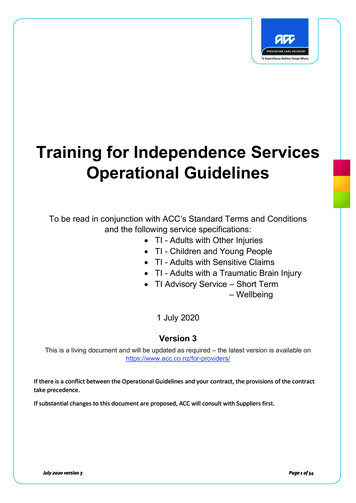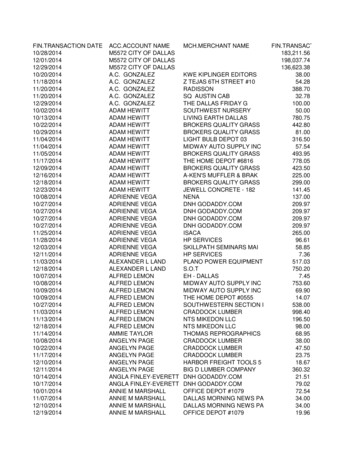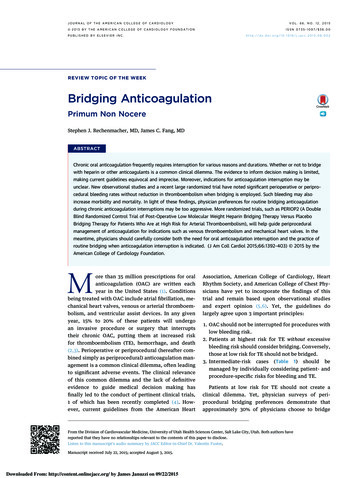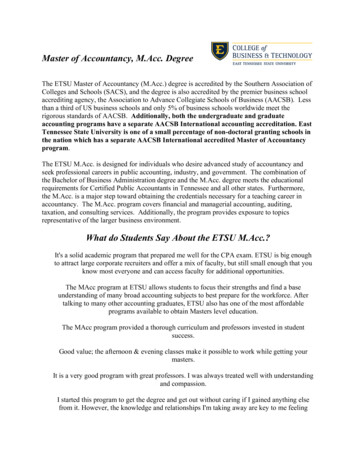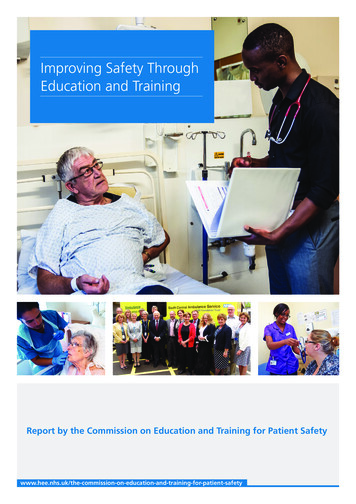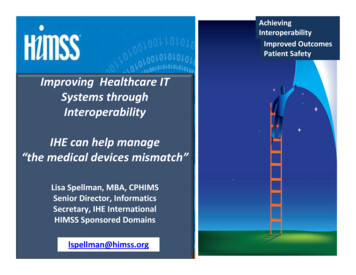
Transcription
2Implementing & ImprovingUpon A STEMI SystemDipti Itchhaporia, MD, FACC, FESCTrustee, American College of CardiologyAssistant Clinical Professor, University of California, IrvineRobert and Georgia Roth Endowed Chair for Excellence in Cardiac CareDirector of Disease ManagementHoag Memorial HospitalNewport Beach, California
DisclosureI have no disclosures
Time is Critical in STEMI CarePrompt diagnosis & treatment reduces death and disability. Shorter time from door-to-balloon (PCI) leads to lower risk of mortality Faster treatment and lower in-hospital mortality associated withhospital “specialization” and emphasis on PCI as principal mode ofreperfusion
Time is Critical in STEMI CareTime and Mortality in STEMI Patients35Longer D2B – higher mortality30.83028.12523.320Mortality, %15.41510500 to 60 minTerkelsen CJ JAMA 2010;304:763-77161 to 120min121 to 180min181 to 360min
Barriers to Timely Reperfusion The patient Failure to promptly recognize symptoms Hesitation to seek medical attention Time to transport Mandated delivery to the closest hospital,regardless of PCI capabilities Long transport in rural areas Decision process on arrival Clot-busting drugs vs. PCI Off hours Transfer to PCI facility Time to implement treatmentstrategy Procedural factors Team assembly6
The Ideal Patient & System Patients and the public: Recognize the symptoms of STEMI Realize the importance of: Activating emergency medical services (EMS) via 9-1-1 promptly Getting treatment quickly Are familiar with their local hospital’s role in STEMI care The ideal system: Promotes education efforts for the Emergency Medical System,the Emergency department personnel, cath lab staff, physiciansand the patients. Provides coordinated and patient-centered care7
The Reality of Today’s Patients Not all STEMI patients call 9-1-1 50% of STEMI patients present to their local emergency department (ED) “Walk-in” patients Rapid ECG CODE 10 Established – ECG in under 10 minutes from time of arrival (DOORTIME) Operational Considerations CODE 10 called overhead in ED multiple available ECG machines process in place to mobilize ECG machine and tech training/ competency of Emergency Care Techs to perform ECG high priority of ED MD to read ECG8
Patient to ED by Ambulance Coordination with Emergency Medical System 12 Lead ECG performed in field Appropriate ECG machines on ambulance capable of transmitting clean tracing Training/ competency of EMT to perform ECG EMS transmits to Base Hospital, BH contacts Cardiovascular Receiving Center(CVRC) Our institution is both a BH and CVRC Radio MICN RN receives call Notifies ED MD, ED RN, Activates CATH LAB – simultaneously ED MD contacts ED CALL PANEL On Call Interventional Cardiologist
PROCESSSTEMI Presentation: EMS v. Walk-InEMS STEMI Recognition by EMS Pre-HospitalPrior to “DOOR” Education & Collaboration with EMSfor timely and accurate 12 Lead ECG Pre-hospital activation of ED, CCU & CCLTeam CODE STEMI 30 minute arrival time ED MD interprets ECG upon pt arrival,repeats if necessary.Walk-In STEMI Recognition upon arrival ofWalk–In CODE 10:ECG within 10 min ED MD primary interpretation ofECG with simultaneous activation ofIC and CCL TEAM10
The Ideal Emergency Medical System (EMS) In an ideal system: Ambulances are equipped with 12-lead ECG machines EMS providers are trained to: Use and transmit 12-lead ECGs Care for STEMI patients Provide feedback on performance and compliancewith guidelines Standardized point-of-entry (POE) protocols define patienttransport rules When there is STEMI, the cath lab is activated promptly Patients transported to a STEMI-referral hospital remainon the stretcher with EMS present pending a transport decision When “walk-in” patients present to a STEMI-referral hospital andrequire primary PCI, activation of EMS occurs Hospitals close the communication gap with EMS11
STEMI TreatmentGOAL: Achieve D2B 90 minutes 60 minutes Key Criteria–Early activation–Door to Data/ECG 10 min–Door to Decision 15 min–Door to Cardiac Cath Lab (CCL) 30 minutes–CCL door to Ready for Stick 10 min–CCL door to BLN 45 min12
Early Data13
Dedicated Mobile Phones in EDFor STEMI NotificationSTEMISTEMI Programmed with IC Cell Numbers ED MD speaks directly with IC Program IC’s cell phones with ED Cellidentifier as “STEMI”14
Next StepsTracking ProgressCreate evaluation mechanism to track progress andoutcomes- and give feedback
Primary PCI Data Collection FormCardiac Cath Lab ResponsibilityEmergency Department ResponsibilityThis is NOT a Permanent Part of the Patient's RecordBenchmark Time or GoalREFERENCEData ElementTimeDate AND Time ED notified of patient arrival:Arrival by: EMS BLS Walk-InOCS-EMS Identification (run) #:Medical Record #:Patient Age: Male FemalePlease copy and attach:1.) EMS field ECG,2.) EMS run Sheet,3.) ECG(s) from ED,4.) ED triage sheetDate & time patient first arrives to Hoag:ED Physician:"Door" ie.: Arrival to hospital"Door to Data"National Goal 10 minutesHoag Goal 10 minutesInitial ECG obtained: EMS HoagTime 1st ECG obtainedSTEMI? Yes NoIf EMS ECG, was the field interpretation confirmed?Yes NoED calls Perfect Serve to activate Call TeamED calls Interventional CardiologistInterventional Cardiologist:"Door to Decision"Hoag Goal 15 minutesCall Team arrival time to hospital:Hoag Goal 30 minutesfollowing notificationCardiologist arrival time to hospital:Hoag Goal 30 minutesfollowing notificationPatient ready for transport to CCL:ED arrival to CVL arrivalHoag Goal 40 minutesPatient arrives in CCL from ED(Please document if room not available.)Patient ready - prepped & draped"CCL door to ready"Hoag Goal 10 minutesLocalArtery Open (time of 1st balloon inflation)Culprit artery:"Lab ready to Stick Time"Hoag Goal 0 minutes"CCL arrival to balloon"Hoag Goal 45 minutes"ED to lab"Hoag Goal 5 minutesPrimary PCIData CollectionForm Initiated Dec 2010 Completed by designated CCLRN’s Reviewed and reported byAMI Team Leaders Immediate, real-timefeedback for allImmediate post-procedure pt disposition &/or location:Total ED door to balloon (D2B) time Total EMS to balloon (E2B) time Goal D2B 90 minutesGoal E2B 90 minutes16
Door 2 Balloon Time (in Minutes)17
Partners for Success Patients and care giversEMS providersPhysicians, nurses and other providersSTEM-referral (non-PCI) hospitalsSTEMI-receiving (PCI-capable) hospitalsHealth systemsDepartments of healthEMS regulatory authority / office of EMSQuality improvement organizationsState and local policymakers18
Reference : Patrick T. O'Gara, Frederick G. Kushner, Deborah D. Ascheim, Donald E. CaseyJr, Mina K. Chung, James A. de Lemos, Steven M. Ettinger, James C. Fang,Francis M. Fesmire, Barry A. Franklin, Christopher B. Granger, Harlan M.Krumholz, Jane A. Linderbaum, David A. Morrow, L. Kristin Newby, Joseph P.Ornato, Narith Ou, Martha J. Radford, Jacqueline E. Tamis-Holland, Carl L.Tommaso, Cynthia M. Tracy, Y. Joseph Woo, David X. Zhao 2013 ACCF/AHAGuideline for the Management of ST-Elevation Myocardial Infarction:Executive Summary, A Report of the American College of CardiologyFoundation/American Heart Association Task Force on Practice GuidelinesJournal of the American College of Cardiology. JACC Volume 61, Issue 4,January 2013
Activating emergency medical services (EMS) via 9-1-1 promptly Getting treatment quickly Are familiar with their local hospital’s role in STEMI care The ideal system: Promotes education efforts for the Emergency Medic
